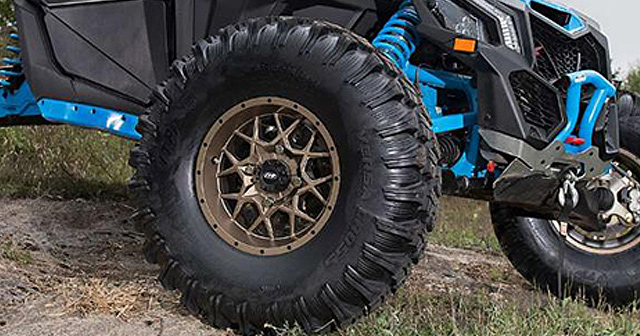
Each of those tire types has a whole spectrum of different varieties to help you fine-tune your ride. There are tons of different tread patterns out there: mud, road, sand, all-terrain, and race, to name a few. What do you want out of a tread pattern? Do you want an ultra-aggressive tread that will chew up and spit out anything you roll over? I bet you do, and while that’s the perfect tread pattern for some riders, that might not be exactly what you need. If you’re willing to lift, tune, and tweak your machine to perfection, then the sky’s the limit. If you’re just starting to think about upgrading your tire size, just go up an inch or two from stock. Simply going big without the proper considerations could leave you with a gimped machine that’s not good for much. Huge 40″ tires can turn your machine into the monster you always imagined it as… if you’re willing to put in the work. (It’s a complicated gear-ratio-type thing.) So Do I Want Bigger Tires? Every inch that you increase your tire size costs you torque, regardless of weight change. Bigger tires mean more weight and more work for your machine, which can put a strain on some of your vehicle’s most crucial parts.Įvery pound you add to your tire is torque that you lose. Bigger isn’t always better when it comes to UTV tires. That means you’ll need to invest in a lift if you want to go any bigger. A 2017 Maverick X3 can fit 30″ tires, but they’ll rub a little bit in the rear. A 2018 RZR XP Turbo, for example, can fit 32″ tires on stock suspension. Plus, your stock machine can only fit up to a certain size before the tire starts rubbing. What’s the solution? A new clutch kit can help save your belts, but aftermarket axles are your only cure if your stock axles start snapping. We’re talking busted axles and shredded belts. If you add too much weight, your drivetrain will take a beating. Think about it-a bigger tire means more weight and more work for your machine just to spin them. There are a lot of good reasons to stick with a smaller tire, not the least of which is the toll a big tire takes on your machine. Every bump feels smaller when your tire is bigger. With a big enough tire, you’ll roll right over them without much effort. They’re great for rocks, fallen trees, and other trail blips. Monster tires are great for mud boggin’ because they allow you to plow through those mud holes without submersing your cab. If you’re a fan of mud, you’re gonna want some big mud tires. That means more grip and less drag because your machine doesn’t have to plow through all that peanut butter. When Are Bigger Tires Better?īigger is better when you need to roll over serious obstacles and need major clearance.īig tires (we’re talking 32″+) are popular with the mud-boggin’ crowd because they can reach the bottom of the mud hole without putting you neck-deep in the mud. That might apply to beds and bank accounts, but that’s not always true when it comes to tires. You may not know what you want out of a new set of tires, but I’m guessing you know you want to go big! Why? Because bigger is better, of course! You really need to pick a tire size that works for your machine, not for your ego. But how do you know which one is right for you? Let us break it down and explain what’s what when it comes to off-road tire size, tread, and pressure. If you think your ride sucks, it might just be the tires. It can even make your vehicle harder to drive.Ĭhoosing the right tire can make a world of difference in your ride’s overall feel and performance. Sometimes the best-looking tire-you know, the one with treads like a chainsaw on steroids that makes your hackles stand up-isn’t the best for your riding style.

If you’re not running the right tire, you’re undercutting your machine’s potential.


 0 kommentar(er)
0 kommentar(er)
